What is the difference between an RCD and a differential circuit breaker and which is better to use?
One of the stages of installing a home electrical network is to install protective equipment. It is mounted in the apartment electrical panel.In the event of increased load or failure, the device responds quickly to protect the entire system or a separate circuit.
But before installation, you should find out what is the difference between an RCD and a differential circuit breaker in order to properly organize and secure your home network.
We suggest you understand the functional features of switching devices and find out in what situation what is best to use. In the article, we outlined the main criteria for choosing electrical protective devices, and also described the specifics of their connection and operation.
The content of the article:
The need for power grid protection
A home electrical system is a complex branched network consisting of many circuits - lighting, sockets, separate power and low-current circuits. It includes all electrical installations that have to be used daily. The simplest among them are sockets and switches.
During the operation of household electrical appliances, unforeseen situations arise, which result in the failure of individual circuits, devices, as well as accidents.
The causes of trouble are the following:
- excessive load on power lines;
- leakage currents;
- short circuits.
You can encounter overload if you use new powerful equipment in an apartment with old wiring. The cable cannot withstand the total load, overheats, melts and fails.
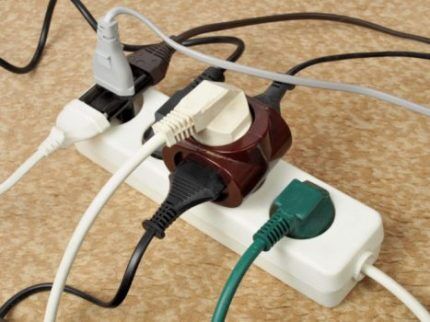
The danger of leakage currents appears when the insulation of electrical cables and devices becomes unusable, or the equipment is installed incorrectly or grounded.
If the current rises above 1.5 mA, the effects of electricity become noticeable, and more than 2 mA causes convulsions.
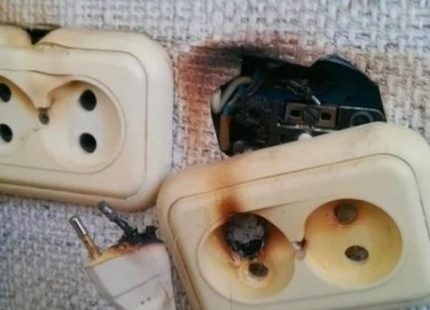
To protect equipment, property, and most importantly, the life and health of residents, emergency shutdown devices are used. Without them modern electrical wiring system in the apartment or private house considered inferior and dangerous.
Load disconnect switching devices
If the electrical system of an apartment or house is divided into separate circuits, it is recommended to equip each line of the electrical circuit with a separate circuit breaker, and install an RCD at the output.
However, there are many more connection options, so first you need to understand the difference between an RCD and a differential circuit breaker, and then carry out the installation.
Circuit breakers - modified “plugs”
When there was no question of a variety of protective devices, when there was excessive load on the line, “plugs”—the simplest emergency devices—triggered.
Their functionality has been improved and received circuit breakers, which operate in two cases - when a short circuit occurs and when the load increases, close to critical.
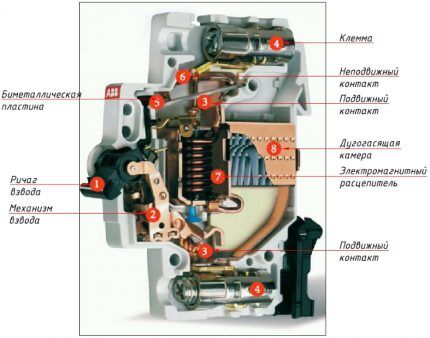
One electrical panel can contain one or several switches, their number depends on the number of circuits serving the apartment or house.
The more separate lines, the easier it is to replace or repair electrical devices. To install one device, you do not need to disconnect the entire network.
A prerequisite for assembling a home electrical network is connecting the machine. Breakers trip quickly when the system is overloaded and due to a short circuit. The only thing they cannot protect against is leakage currents.
RCD – automatic protection devices
Exactly RCD is a device that automatically analyzes the current strength at the input/output and protects against leakage currents. The shape of the body is similar to a circuit breaker, but it works on a different principle.
Inside the housing there is a working device - a core with windings. The magnetic fluxes of the two windings are directed in opposite directions, which creates balance. Thus, the magnetic force in the core is reduced to zero.
As soon as leakage current occurs, a difference in magnetic flux values appears - the output value decreases. As a result of the interaction of the flows, the relay is triggered and breaks the circuit. The response time interval is within 0.2-0.3 seconds. This time is enough to save a human life.
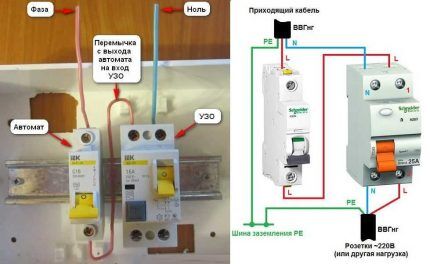
On the case you can see the markings 10 ... 500 mA. This indicates the rated leakage current. For home use, an RCD with a rating of 30 mA is usually chosen.
Devices marked 10 mA can be useful if a separate circuit is routed to a children's room or bathroom where there is a high level of humidity.
The RCD protects against leakage currents, but is useless with increased load on the wires, and also will not help in the event of a short circuit. For this reason, two devices - an RCD and a circuit breaker - are always mounted in pairs.
Only together will they provide a full degree of protection, which must be present in every household electrical system.
Differential automatic – maximum protection
When we talk about how RCD fundamentally differs from differential machine, then we do not mean a separately installed RCD device, but a pair “RCD + switch”.
An automatic residual current switch (RCCB), in its essence, is this pair, but combined in one housing.
Thus, it immediately performs three main functions:
- protects against leakage currents;
- prevents line overload;
- Instantly triggered in the event of a short circuit.
Despite its small size, the device operates efficiently and quickly, but under one condition - if it is produced under a reliable, proven brand.
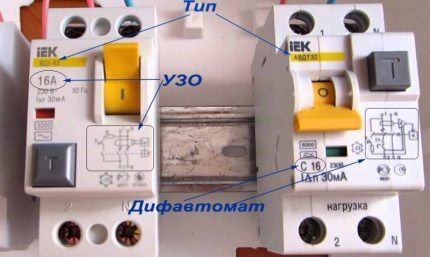
The technical documentation, which is necessarily attached to the device, lists its characteristics. The designation of the most important indicators is printed on the front side of the case.
In addition to the name marking, the rated load current and leakage current are indicated here. The units of measurement are the same as for simple machines - mA.
At first glance, it may seem that the appearance of a difavtomat completely negates the initially existing “switch + RCD” circuit. However, there are many nuances that govern the choice of one solution or another, and as a result, both installation schemes are relevant and in demand.
Criteria for selecting electrical protection devices
Let's try to figure out what is better for the home - an RCD or a differential circuit breaker, and consider various installation situations. Most often, the choice is influenced by factors such as the position of the device in the electrical panel, the nuances of connecting to power lines, and the possibility of maintenance or replacement.
Features of installation in an electrical panel
An electrical panel is a metal box, inside of which protection devices and an electric meter are usually located. The working panel to which the devices are attached is limited in size.
If the electrical network is improved and additional modules are installed, then there is a shortage of free spaces on the DIN rails. In this case, difautomats find themselves in an advantageous position.
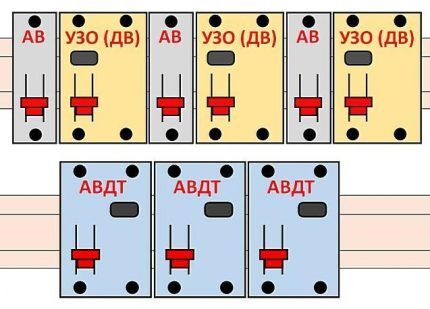
Modern equipment of apartments with electricity is focused on increasing the number of circuits. This is due to the emergence of a large number of powerful equipment, and to the division of the network into many lines. In such a situation, in the absence of additional space, the only reasonable solution is connection of difavtomats.
When selecting devices, pay attention to devices that occupy one module-space. Such models have already appeared on sale, but their cost is slightly higher than traditional ones.
Difficulty connecting wires
The main difference in connection between the two indicated options is the number of wires. Two separate devices have more terminals in total - 6 pieces, while the difavtomat has only four.The connection diagram is also different.
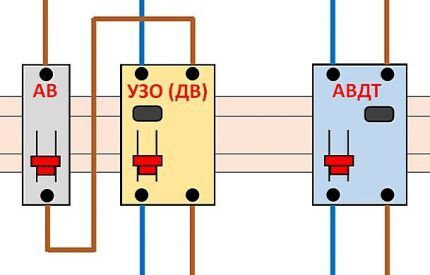
The diagram clearly shows the wiring connections.
At connecting a pair of AB + RCD the schedule is like this:
- the phase wire is connected to terminal AB;
- the output of the machine and the L-terminal of the RCD are connected by a jumper;
- the output of the RCD phase is sent to electrical installations;
- the neutral wire is connected only to the RCD - at the input with the N-terminal, at the output - it is sent to electrical installations.
With a difavtomat, the connection is much simpler. Jumpers are not needed, just connect phase and neutral to the corresponding terminals, and send them from the outputs to the load.
What does this give to the installer? Facilitates the connection process, reduces the number of wires, and, accordingly, guarantees more order in the electrical panel.
How is triggering diagnosed?
If we consider devices from the middle price segment, then the tandem “automatic device + RCD” has advantages. Suppose there was an emergency power outage on one of the circuits.
It is difficult to immediately determine the reason for the protection to operate, since it could be a leakage current, a short circuit, or a total load that the wires could not cope with.

If the automatic machine responded to a network failure, then it will take longer to look for the cause. It is necessary to check all versions, and this will take more time and effort.
To simplify diagnostics, it is recommended to purchase devices from a more expensive price segment - they are equipped with additional indications indicating a possible problem.
Which devices are cheaper to buy and repair?
There are situations where the choice is based on cost. For example, there is a budget that cannot be exceeded. In this case, the total cost of all connected protection devices plays a decisive role.
At first glance, a larger number of devices are characterized by a higher price. In fact, everything is different: a universal automatic machine costs a tidy sum, but a set of other devices turns out to be economical.
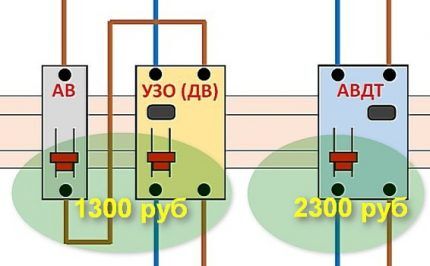
It should be remembered that the number of lines is usually 3 or more, so the difference between purchases increases. If for one circuit the purchase of RCBOs is only 1 thousand rubles more expensive, then for five circuits the difference in amounts grows to 5 thousand rubles.
Thus, both automatic devices and RCD units with circuit breakers have their advantages and disadvantages. If RCBOs win in compactness and ease of connection, then they clearly lose in diagnostics and cost accounting.
Conclusions and useful video on the topic
To better understand security devices and choose the right solution depending on the situation, we suggest watching thematic videos.
Interesting information about the operating principle and installation of RCDs:
Some tips from a professional electrician:
What played a role when choosing a difavtomat:
As you can see, the topic of choosing an RCD or RCBO is not in vain: there are many points that speak in favor of both devices. In order to correctly select the optimal protection option, it is necessary to consider the installation and connection conditions, as well as draw up a preliminary estimate.
Do you have anything to add or have any questions about the topic? You can leave comments on the publication, participate in discussions and share your own experience of using RCDs and differential circuit breakers. The communication block is below.




Yes, safety, avoiding damage to email. electric shock - that's all right. RCD or difavtomat are good for use in ideal operating conditions of new wiring. But in practice it is mostly different. Most people live in houses where the wiring is old and there is undoubtedly a leak. Add here a slight increase in humidity in the room - and the consumer receives a constant activation of the protection, a tedious search for the cause of the shutdown (and does not find it in 99 cases out of 100, since the wiring is hidden in most cases), ultimately removes the RCD from the circuit, leaving only machine.